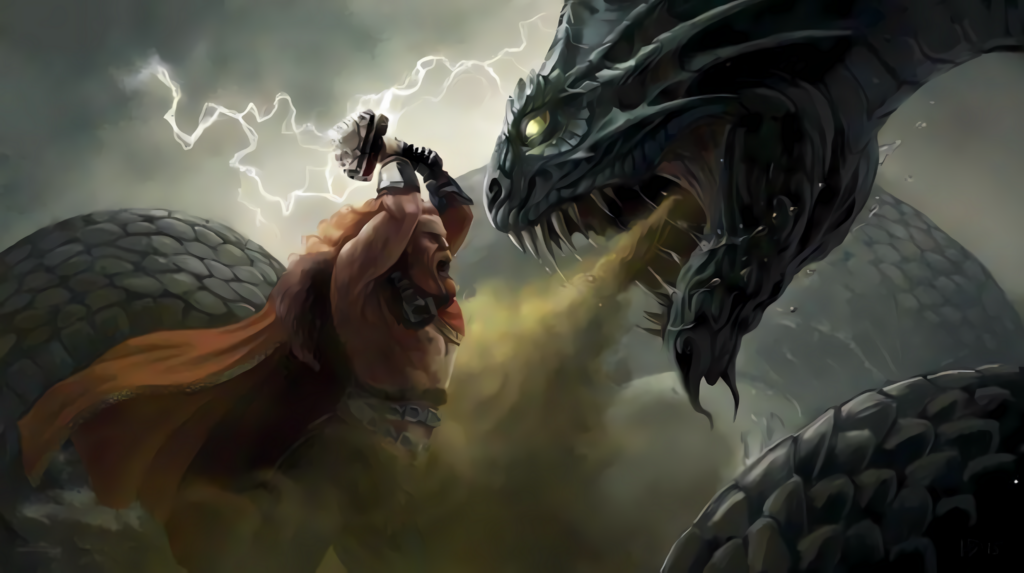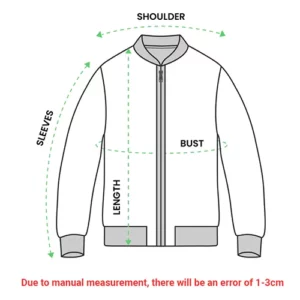In Norse mythology, Jörmungandr is a giant serpent who plays an important role. Also known as the Midgard Serpent or World Serpent, Jörmungandr encircles the entire world in the great ocean that surrounds Midgard, the mortal realm. According to Norse legends, Jörmungandr was the result of an affair between the troublemaker god Loki and the giantess Angrboða. This serpent would go on to have epic battles against Thor, the mighty god of thunder, during Ragnarök, the prophesied end of the world.
Physical Description
The poems and tales of Norse mythology provide some vivid descriptions of Jörmungandr’s frightening physical form. He is depicted as having a straight back with many sharp spikes or spines running along it. His head somewhat resembles that of a furious bear but his body is long and serpentine like a fish, with scales as smooth and hard as armor. Despite his slippery scales, the god Thor was able to capture Jörmungandr at least eight times using an enormously powerful magical fishing net that he forged himself and took 999 days to construct. Even so, the cunning serpent often managed to wriggle free and elude Thor’s grasp, greatly angering the thunder god.
Origin and Early Life
Jörmungandr first appeared in Norse mythology as one of three monster children born to Loki and the female jötunn Angrboða. The other two were the gigantic wolf Fenrir and the evil goddess Hel. Odin, the king of the Norse gods, took the children away from their parents out of concern for what future trouble they might cause. He had Jörmungandr tossed into the great surrounding ocean that encircles Midgard. There, Jörmungandr grew to such an immense size that he was able to bite his own tail, thus encircling the entire Earth.
As Jörmungandr matured, he gained increasing power over the seas and oceans around Midgard. This serpent became a formidable force of nature, with his writhings able to generate massive tsunamis and whirlpools. However, his presence also brought balance to Midgard by maintaining the waters surrounding the realm. Though a frightening beast, Jörmungandr played an integral role in Norse cosmology by encircling the mortal world.
Battles with Thor
Jörmungandr’s greatest foe was the thunder god Thor. In the poetic sources of Norse mythology, it is said that Thor embarked on many adventures sailing across the seas, where he encountered and battled Jörmungandr at least eight times. Their clashes were epic struggles, as Thor attempted to use his powerful magic fishing net and enchanted hammer Mjöllnir against the mighty serpent. However, Jörmungandr’s scales were incredibly tough, and he was a slippery adversary who often managed to escape Thor’s grasp.
In one example from the Eddic poem Hymiskviða, Thor tried to capture Jörmungandr using a ferry-boat skull as bait. But the wary serpent outwitted Thor by biting part of the boat instead of the bait, allowing him to wriggle free once more. These failed battles against Jörmungandr greatly aggravated Thor and became renowned exploits in Norse mythology, demonstrating the immense power and guile of the World Serpent.
Ragnarök Prophecy

Jörmungandr plays a climactic role in Norse end-times prophecy. According to the Völuspá, during Ragnarök, the fated battle at the twilight of the gods, Jörmungandr and Thor are destined to engage in one final battle that will decide the outcome of the war. As the forces of Muspellheim surge forth led by Surtr the fire giant king, Jörmungandr rises up from the ocean with such force that his poisons spread through all waters and his dreadful staring eyes strike terror across the lands.
When Thor sees his ancient foe emerge once more, the two adversaries engage in the fight of their lives. Despite Thor’s valiant efforts, Jörmungandr wraps himself around the thunder god, his spines piercing Thor’s armor. Yet Thor prevails and slays Jörmungandr by bashing him with his mighty hammer, striking a death blow upon the World Serpent. However, before expiring, Jörmungandr manages to spit venom from his fangs that kills Thor as well. Their mutual destruction signals the downfall of the gods and the end of the world.
Later Influences
Even after Christianization eroded Norse pagan beliefs, the powerful figure of Jörmungandr persisted in later Scandinavian folklore traditions. He became associated with natural forces like whirlpools and tidal waves. His monumental form also featured prominently in classical European architecture, often carved into the juncture of walls, pillars and floors to symbolize the cosmos. Additionally, Jörmungandr’s imagery blended with the ancient symbol of Ouroboros, the serpent eating its own tail, to represent infinity or cyclic renewal.
The Legend Today
Modern media has popularized Jörmungandr as a primordial snake-like embodiment of untamed natural forces. He appears in various role-playing games and fiction works drawing from Norse mythology. Jörmungandr has become a globally recognized figure, part of the growing widespread interest in Norse pagan spirituality and cosmology. His epic battle against Thor at Ragnarök remains one of the most famous scenes from Norse eschatology. Overall, Jörmungandr endures as a powerful and primordial symbol, representing the cyclicality of nature, birth and destruction in Norse mythology and Germanic pagan traditions.















